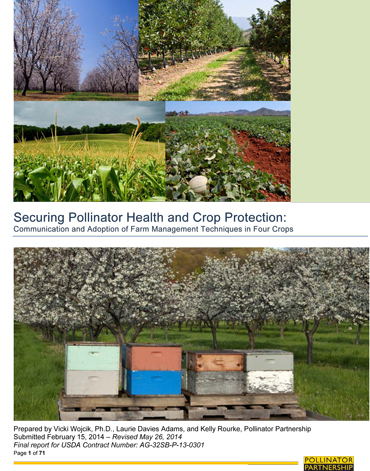
Securing Pollinator Health and Crop Protection: Communication and Adoption of Farm Management Techniques in Four Crops
Pollinator Partnership (P2) was contracted by the USDA and the EPA to conduct a review of crop protection best management practices (BMPs) when considering the health and safety of bees.
This report examines the presence and nature of actions and activities involving pesticide application that affect pollinator protection in three representative commercially-pollinated specialty crops (almonds, apples, and melons) and in one commodity crop (corn). The goal of this review is to understand the tools available to stakeholders in these cropping systems, understand the awareness of pollinator protection measures, and determine any barriers that might exist to adopting pollinator protection practices within a management framework. This report focuses on bees, both managed and wild, within or adjacent to each cropping system, and their interactions with applied pesticides and other pest management products.
Overall, BMPs during bloom are understood and pollinator protection is made a priority for most crop growers and applicators. Common practices include carefully reading product labels, night-spraying, and equipment maintenance. Protection methods in pre- and post-bloom periods are less prevalent, sometimes nonexistent. Resources available on a regional or state level are inconsistent. BMPs for pest, fungus, and disease management can be designed to safeguard both pollinators and crop production.
In this report P2 outlines a set of recommendations based upon a review of the current status of pollinator protection BMP’s availability, quality, awareness, and distribution. Our recommendations include increased awareness and promotion of existing techniques; technical enhancement and the development of new outreach materials; and the initiation of research that will fill technical data gaps. We recommend the expansion of current BMPs and the diversification of distribution networks. The repackaging of good BMPs into formats and languages that are more accessible and available will increase the likelihood of adoption. We also recommend new research in some areas to better understand how all pollinators interact with commonly used pesticides and ways to increase Integrated Pest Management (IPM).
The Pollinator Partnership hopes that this report will lead to the implementation of year round and geographic specific BMPs with an emphasis in communication and user friendly resources.
